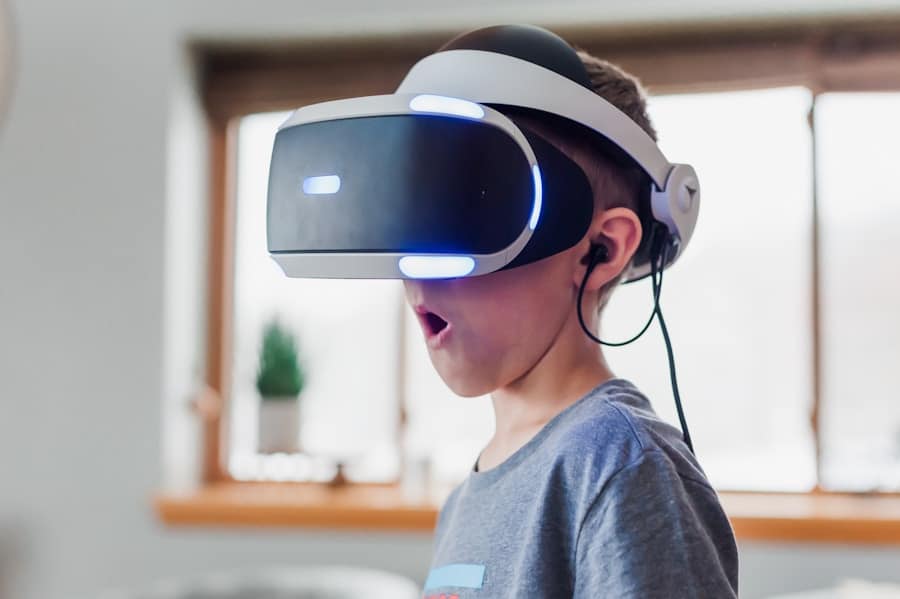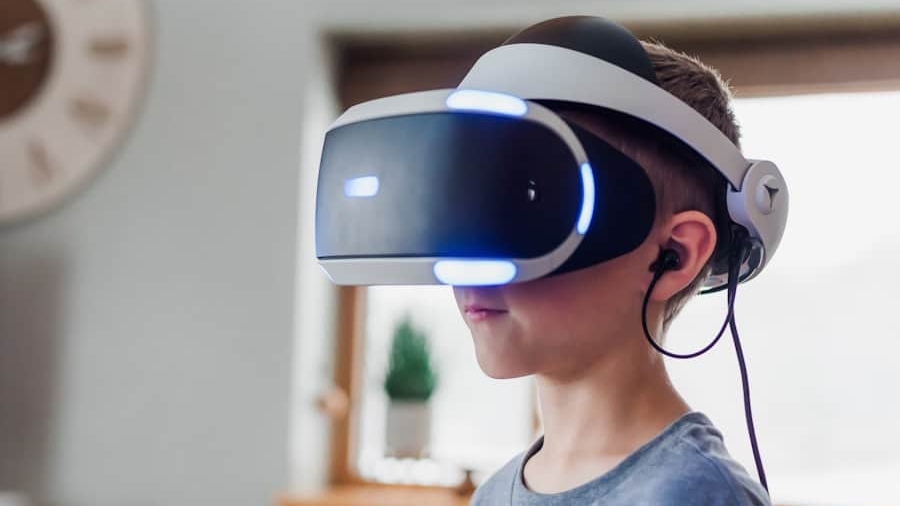Virtual Reality (VR) has emerged as a transformative technology with the potential to revolutionize various fields, including healthcare. In pediatric medicine, where the emotional and psychological well-being of young patients is paramount, VR offers innovative solutions to address the unique challenges faced by children undergoing medical procedures. The immersive nature of VR can create engaging environments that distract from pain and anxiety, making it a valuable tool in pediatric healthcare settings.
As children often struggle to articulate their fears and discomfort, VR can serve as a bridge, allowing them to navigate their experiences in a more manageable way. The potential impact of VR on pediatric patients extends beyond mere distraction; it encompasses a holistic approach to treatment that considers the psychological aspects of healthcare. By immersing children in calming or entertaining virtual environments, healthcare providers can help mitigate the stress associated with medical visits, surgeries, or treatments.
This technology not only enhances the patient experience but also has implications for improving overall health outcomes. As we delve deeper into the intersection of VR and pediatric care, it becomes evident that this technology could redefine how we approach anxiety management in young patients.
Key Takeaways
- VR has the potential to positively impact pediatric patients by providing distraction and relaxation techniques, reducing anxiety, and improving overall well-being.
- Anxiety in pediatric patients can have a significant impact on their health, and understanding its effects is crucial for effective treatment and management.
- VR plays a significant role in providing distraction and relaxation techniques for pediatric patients, helping to alleviate anxiety and improve their overall experience in healthcare settings.
- Research and studies have shown the effectiveness of VR in reducing anxiety in pediatric patients, highlighting its potential as a valuable tool in pediatric healthcare.
- Practical applications of VR in pediatric healthcare settings include using VR for pain management, procedural support, and anxiety reduction, providing a promising avenue for improving the well-being of pediatric patients.
Understanding Anxiety in Pediatric Patients and its Impact on Health
The Consequences of Anxiety on Health
The impact of anxiety on health is substantial, leading to avoidance of necessary medical care, increased pain perception, and longer recovery times. It is essential to understand the roots of anxiety in children to develop effective interventions. Moreover, the implications of untreated anxiety extend beyond immediate discomfort.
The Long-term Effects of Anxiety
Chronic anxiety can significantly affect a child’s development, leading to difficulties in social interactions, academic performance, and overall quality of life. Pediatric patients with high levels of anxiety may also be more susceptible to developing long-term mental health issues, such as depression or generalized anxiety disorder.
The Importance of Innovative Solutions
Addressing anxiety in pediatric patients is crucial for fostering resilience and promoting healthier developmental trajectories. This understanding highlights the importance of integrating innovative solutions, such as virtual reality, into pediatric healthcare practices to alleviate anxiety and promote better health outcomes.
The Role of VR in Distraction and Relaxation Techniques for Pediatric Patients

VR technology offers a unique avenue for distraction and relaxation techniques tailored specifically for pediatric patients. By immersing children in captivating virtual worlds—whether it be exploring underwater landscapes or embarking on fantastical adventures—VR can effectively divert their attention away from the stressors associated with medical procedures. This distraction is particularly beneficial during painful or anxiety-inducing treatments, as it can significantly reduce the perception of pain and discomfort.
In addition to distraction, VR can also facilitate relaxation through guided imagery and calming environments. For instance, virtual experiences that simulate serene natural settings can help lower heart rates and promote a sense of tranquility. These experiences can be designed to engage multiple senses, incorporating soothing sounds and visuals that encourage deep breathing and mindfulness.
By combining elements of play with therapeutic techniques, VR not only alleviates anxiety but also empowers children to take an active role in managing their emotional responses during medical encounters.
Research and Studies on the Effectiveness of VR in Reducing Anxiety in Pediatric Patients
Numerous studies have explored the effectiveness of VR in reducing anxiety among pediatric patients, yielding promising results that highlight its potential as a therapeutic tool. For example, a study published in the journal *Pediatrics* examined the use of VR during intravenous catheter placements in children. The findings indicated that those who experienced VR reported significantly lower levels of anxiety compared to those who did not use VR during the procedure.
This reduction in anxiety was accompanied by lower pain scores, suggesting that VR not only distracts but also alters the overall experience of medical interventions. Another notable study focused on children undergoing dental procedures, where VR was employed as a distraction technique. The results demonstrated that children who engaged with VR reported feeling less anxious and were more cooperative during treatment.
These studies underscore the efficacy of VR as an adjunctive therapy in pediatric settings, providing empirical support for its integration into standard care practices. As research continues to evolve, it is essential to explore various applications of VR across different medical contexts to fully understand its impact on pediatric anxiety management.
Practical Applications of VR in Pediatric Healthcare Settings
The practical applications of VR in pediatric healthcare settings are diverse and continually expanding. One prominent use is during preoperative preparation, where children can engage with VR simulations that familiarize them with the surgical environment and procedures they will undergo. This exposure can significantly reduce fear of the unknown and help children feel more comfortable when facing surgery.
Additionally, VR can be utilized during post-operative recovery to distract patients from pain and discomfort while promoting relaxation. Another application lies in outpatient settings, where VR can be integrated into routine check-ups or minor procedures such as vaccinations. By providing an engaging virtual experience during these visits, healthcare providers can help alleviate anxiety associated with needles or unfamiliar environments.
Furthermore, VR can be employed in therapeutic contexts, such as cognitive-behavioral therapy (CBT) for children with anxiety disorders. By creating controlled virtual scenarios that expose children to their fears in a safe environment, therapists can facilitate gradual desensitization and coping strategies.
Challenges and Limitations of Implementing VR for Anxiety Reduction in Pediatric Patients

Despite its promising potential, implementing VR for anxiety reduction in pediatric patients is not without challenges and limitations. One significant barrier is the cost associated with acquiring and maintaining VR equipment. High-quality VR systems can be expensive, and not all healthcare facilities may have the resources to invest in this technology.
Additionally, there may be logistical challenges related to integrating VR into existing workflows within busy pediatric departments. Another concern involves the variability in children’s responses to VR experiences. While many children may find VR engaging and helpful for managing anxiety, others may experience discomfort or disorientation while using headsets.
It is crucial for healthcare providers to assess individual preferences and comfort levels before introducing VR as an intervention.
Future Directions and Potential Innovations in VR for Pediatric Anxiety Management
The future of VR in pediatric anxiety management holds exciting possibilities as technology continues to advance. One potential direction is the development of more personalized VR experiences tailored to individual children’s preferences and needs. By utilizing artificial intelligence (AI) algorithms, healthcare providers could create adaptive virtual environments that respond to a child’s emotional state in real-time, enhancing engagement and effectiveness.
Moreover, advancements in haptic feedback technology could further enrich the immersive experience by allowing children to interact with virtual objects in a more tangible way. This could enhance the sense of presence within the virtual environment and provide additional distraction during medical procedures. Additionally, integrating biofeedback mechanisms into VR systems could enable real-time monitoring of physiological responses, allowing healthcare providers to adjust interventions based on a child’s stress levels.
As research continues to explore the efficacy of VR across various medical contexts, collaborations between technologists, clinicians, and researchers will be essential for driving innovation forward. By fostering interdisciplinary partnerships, we can develop comprehensive solutions that address not only anxiety but also other emotional challenges faced by pediatric patients.
The Promising Role of VR in Improving the Well-being of Pediatric Patients
The integration of Virtual Reality into pediatric healthcare represents a significant advancement in addressing the emotional needs of young patients. As we have explored throughout this article, VR has demonstrated its potential to reduce anxiety through distraction and relaxation techniques while also enhancing overall patient experiences during medical encounters. The growing body of research supporting its effectiveness underscores the importance of continued exploration and implementation within clinical settings.
As we look toward the future, it is clear that innovations in VR technology will play a crucial role in shaping how we approach pediatric anxiety management. By embracing this transformative tool, healthcare providers can create more supportive environments that prioritize both physical health and emotional well-being for children facing medical challenges. The journey toward fully realizing the potential of VR in pediatric care is just beginning, but its promise offers hope for improving the lives of countless young patients navigating their healthcare journeys.
A related article to The Impact of VR on Reducing Anxiety in Pediatric Patients is “Discover the Best Free Software for Home Remodeling Today” which discusses various software options for homeowners looking to remodel their homes. This article can be found at this link.
FAQs
What is VR?
VR stands for virtual reality, which is a computer-generated simulation of an environment that can be interacted with in a seemingly real or physical way by a person using special electronic equipment, such as a helmet with a screen inside or gloves fitted with sensors.
How does VR reduce anxiety in pediatric patients?
VR has been shown to reduce anxiety in pediatric patients by providing a distraction from medical procedures, creating a sense of presence in a calming environment, and offering a form of cognitive behavioral therapy to help patients manage their anxiety.
What are the benefits of using VR to reduce anxiety in pediatric patients?
The benefits of using VR to reduce anxiety in pediatric patients include decreased need for sedation during medical procedures, improved patient cooperation and satisfaction, and reduced post-procedural distress and pain.
Are there any risks or side effects associated with using VR in pediatric patients?
While VR is generally considered safe for pediatric patients, some potential risks and side effects include motion sickness, eye strain, and disorientation. It is important for healthcare providers to monitor patients closely and ensure that VR is used appropriately.
What types of VR experiences are most effective for reducing anxiety in pediatric patients?
VR experiences that are immersive, interactive, and tailored to the individual patient’s preferences and needs have been shown to be most effective for reducing anxiety in pediatric patients. This may include virtual environments that are calming, engaging, and provide a sense of control for the patient.

